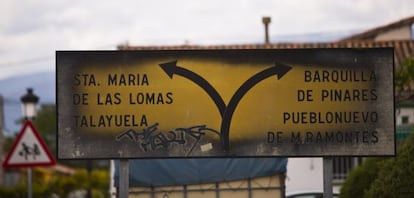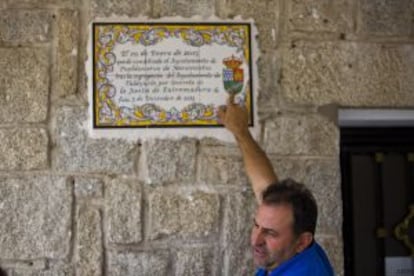Can 10-person towns have a future?
Nearly half of the country’s 8,122 municipalities have fewer than 500 residents But mergers are not on the cards: seven new villages will hold first elections this May 24


There are 8,122 municipalities in Spain. Of these, 84 percent have fewer than 5,000 inhabitants, while nearly half – 48 percent – have under 500.
There are also 1,220 hamlets with 100 residents or fewer, and nine locations where the local population does not exceed 10 people.
The figures, provided by the Finance and Public Administrations Ministry, also show that the smallest Spanish municipality, Illán de Vacas, in central Toledo province, has just three residents. For years, the only person on the local electoral rolls was the mayor.
To propose merging the smallest municipalities is like performing political hara-kiri, because you are eliminating thousands of positions for your party members”
Víctor Lapuente, Gothenburg University
For decades, countries across Europe have been merging their smallest administrative entities in the interests of saving public money and ensuring a more rational territorial division.
But in Spain, attachment to one’s village and the desire for micro-autonomy have created the opposite trend: seven new municipalities are due to hold their first elections on May 24. These villages did not exist as independent administrative entities last time Spain held a municipal vote, in 2011.
There are 95 more political jurisdictions today than there were in 1979, while countries such as Denmark, Austria and Greece have slashed theirs by a factor of eight. In the whole of Britain there are just 466 municipalities, compared with 2,248 in the region of Castilla y León alone.
But supporters of the Spanish system note that France has 36,682 administrative entities, making it the only large European country with even smaller villages than Spain.

Demographically, what this means is that the 6,818 smallest locations in Spain represent just 12.5 percent of the Spanish population, while 40 percent of people are crowded into the 62 largest cities.
“Our municipal map is excessively fragmented, which is very negative for services management. But mergers tend to meet with great political resistance,” explains Jacobo García, who teaches geography at Carlos III University in Madrid. “This fragmentation is particularly serious in Castilla y León, Aragón and La Rioja, where many local councils are unable to efficiently deliver the minimum services that they are obliged to provide.”
García feels that “these micro-municipalities are inefficient and politically irrational.”
Trying a new village for size
Up in the bell tower at Pueblonuevo de Miramontes (population 839), a stork clatters its bill, and the peculiar sound blends in with the ding-dong that heralds a municipal announcement. It all sounds very old, but it isn’t. This spot in Cáceres province was settled under Franco in 1957 as a dependency of Talayuela, 26 kilometers away. The town hall displays a coat of arms that was invented just a few years ago, and a wall plaque explains that the village has only been independent since January 2015.
Pueblonuevo de Miramontes is the newest of the seven new municipalities. Three of them are villages in Extremadura founded under Franco (Pueblonuevo, Tiétar and Guadiana del Caudillo), while the others are Andalusian hamlets whose roots go back to Neolithic times (Dehesas Viejas, Valderrubio, Serrato and Montecorto). The largest has a population of 2,519, the smallest only has 500 residents.
And all this, despite the fact that a Local Administration Rationalization and Sustainability Law went into effect in 2013 to promote administrative mergers and prohibit locations of fewer than 500 residents from breaking away.
There has been just one merger as a result of the new law – between Oza and Cesuras in Galicia. The Galician regional government made a big deal of it, even though the mayor of the merged authorities tripled his own salary and the estimated savings of €60,000 amounted to little more than €6,000 in the end.
Meanwhile, seven small villages broke off from larger municipalities. A ministry spokesperson explained that if the segregation petition had already been filed before the new legislation went into effect, the 5,000-resident limit did not apply.
“We always had to go begging to Talayuela, and they only came round at election time,” says Miguel Ángel Sánchez, a councilor at Pueblonuevo de Miramontes and a candidate to become its first mayor. In Pueblonuevo, everyone refers to Talayuela as “Them.”
“They called us ‘the folks from the settlements;’ they would divide up the money and keep the lion’s share,” he says. “They built themselves three soccer pitches and paid no attention to our needs.”

The mayor of Talayuela, Raúl Miranda, believes that independence is not going to be how the people of Pueblonuevo imagined it.
“They always believed that we were sharing out the money unfairly, but they got what they were entitled to,” he says. “Now they will see what it’s all about, and let’s see how they get organized without a local police force, or how they deal with garbage collection all by themselves.”
Standing outside the local school in Pueblonuevo, mothers are wondering the same thing.
“Of course we wanted independence, but let’s see how it goes...” says one.
Over at the local nightclub, Ernesto and Víctor Manuel hope the new administration will bring sports facilities and jobs. People always made a good living here from tobacco until the cropping machines made an appearance. Inside Bar Andi, the older residents are wary: “We’re not going to feel a darned bit of difference,” says one man. “A village of 800 cannot hope for a sports arena.”
Economies of scale
The main reasons for merging municipalities are to take advantage of economies of scale and to reduce government spending. Although most mayors and councilors of small villages make little or no money from their public duties, there are always costs involved with running an administration.
The main reason for breaking off is to gain control over local taxes and subsidies. In other words, the cause of mergers and break-aways is economic.
But getting there is a political game. And if one depends on a larger municipality, things are usually obtained only as part of pacts, favors and campaign promises.
“To propose merging the smallest municipalities is like performing political hara-kiri, because you are eliminating thousands of positions for your party members,” says Victor Lapuente, a political scientist at Gothenburg University in Sweden. “Besides, these micro-municipalities feed the provincial authorities, which is where parties accumulate their power.”
They called us the ‘folks from the settlements;’ they would share out the money and keep the lion’s share”
Miguel Ángel Sánchez, mayoral candidate in Pueblonuevo de Miramontes
Jacobo García, Carlos III University
Only the Union, Progress & Democracy (UPyD) party openly favors forcing mergers among villages with populations of 5,000 or less.
“It would be progressive, and villages would not disappear; instead they would share services, councilors, mayors...” explains party spokesman Carlos Martínez Gorriarán. “We have a study that says that 20,000 is the optimal size.”
Ciudadanos, a party that is running nationally for the first time on a message of change, has a similar proposal on its program.
“We seek the unification of villages, not their suppression,” says Fran Hervías. Podemos, the anti-austerity party, has no specific proposals.
But the more traditional parties are not keen to eliminate mayors.
“The total of 8,122 is not that many,” says Manuel Fuentes of the United Left (IU) coalition. “Services are managed better from a short distance. I doubt that a large village with five or six satellite locations would fairly share out the resources.”
“Little villages need to create a commonwealth for their services,” says Adriana Lastra of the Socialist Party (PSOE). “You cannot take away municipal identity.”

Meanwhile, the ruling Popular Party (PP) says it wants to make small villages more efficient by “strengthening the provincial authorities, which take advantage of economies of scale but respect people’s feelings for their village,” says the PP’s Manuel Cobo.
Because after the economic and the political factors, there is also the sentimental one.
“In the UK, nobody was bothered about mandatory mergers because they are British,” says Francisco Velasco, a professor of local law at Madrid’s Autónoma University. “But in Spain we are from this or that village. People care greatly about it, and you cannot rule against the people. I don’t know whether having so many villages is a good or a bad thing, but it is important.”
This feeling is palpable in places such as Dehesas Viejas, a Granada village that became independent last year.
“The people in Iznalloz gave themselves airs like they were the capital, and treated us as a suburb,” says acting mayor Maximiliano Castilla. “They gave us the street lamps that they’d replaced with newer ones, and we had to go to their funeral parlor to honor our dead... We felt like second-rate citizens, yet we were always a municipality until a 1972 decree changed it. It’s as though you were from Madrid, and one day they told you that you were from Toledo.”
In Tiétar, Cáceres province, which obtained its independence two years ago, identity is created through investment. A monument in the central square pays tribute to “the first settlers” who arrived here in 1961. Inés Morales, a 24-year-old resident, shows an ID card that still states that she lives in Tiétar del Caudillo/Talayuela. “I hadn’t even noticed,” she says. Both she and her friend Tamara feel that the monument is “a silly expense.” But they do agree with the Independence Celebration, which is held in July and includes a DJ and a young bull that will be fought during the fiestas.
Tu suscripción se está usando en otro dispositivo
¿Quieres añadir otro usuario a tu suscripción?
Si continúas leyendo en este dispositivo, no se podrá leer en el otro.
FlechaTu suscripción se está usando en otro dispositivo y solo puedes acceder a EL PAÍS desde un dispositivo a la vez.
Si quieres compartir tu cuenta, cambia tu suscripción a la modalidad Premium, así podrás añadir otro usuario. Cada uno accederá con su propia cuenta de email, lo que os permitirá personalizar vuestra experiencia en EL PAÍS.
¿Tienes una suscripción de empresa? Accede aquí para contratar más cuentas.
En el caso de no saber quién está usando tu cuenta, te recomendamos cambiar tu contraseña aquí.
Si decides continuar compartiendo tu cuenta, este mensaje se mostrará en tu dispositivo y en el de la otra persona que está usando tu cuenta de forma indefinida, afectando a tu experiencia de lectura. Puedes consultar aquí los términos y condiciones de la suscripción digital.
Últimas noticias
Pinochet’s victims grapple with José Antonio Kast’s rise in Chile
Reinhard Genzel, Nobel laureate in physics: ‘One-minute videos will never give you the truth’
How Japan is trying to avert ‘digital defeat’
The complicated life of Francesca Albanese: A rising figure in Italy but barred from every bank by Trump’s sanctions
Most viewed
- Pablo Escobar’s hippos: A serious environmental problem, 40 years on
- Why we lost the habit of sleeping in two segments and how that changed our sense of time
- Trump’s obsession with putting his name on everything is unprecedented in the United States
- Charles Dubouloz, mountaineering star, retires at 36 with a farewell tour inspired by Walter Bonatti
- The Florida Keys tourist paradise is besieged by immigration agents: ‘We’ve never seen anything like this’








































